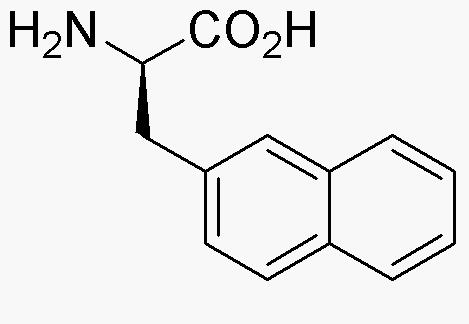3-(2-Naphthyl)-D-alanine is widely utilized in research focused on:
- Pharmaceutical Development: This compound serves as a valuable building block in the synthesis of novel pharmaceuticals, particularly in the development of drugs targeting neurological disorders.
- Peptide Synthesis: It is used in the production of peptides, enhancing the diversity of peptide libraries for drug discovery, which is crucial for identifying new therapeutic agents.
- Biochemical Research: Researchers employ this compound to study protein interactions and enzyme activities, providing insights into metabolic pathways and potential drug targets.
- Material Science: Its unique properties make it suitable for developing advanced materials, such as sensors and organic semiconductors, which are essential in electronics.
- Food Industry: The compound can be explored for flavor enhancement and as a potential additive, contributing to the development of new food products with improved taste profiles.
General Information
Properties
Safety and Regulations
Applications
3-(2-Naphthyl)-D-alanine is widely utilized in research focused on:
- Pharmaceutical Development: This compound serves as a valuable building block in the synthesis of novel pharmaceuticals, particularly in the development of drugs targeting neurological disorders.
- Peptide Synthesis: It is used in the production of peptides, enhancing the diversity of peptide libraries for drug discovery, which is crucial for identifying new therapeutic agents.
- Biochemical Research: Researchers employ this compound to study protein interactions and enzyme activities, providing insights into metabolic pathways and potential drug targets.
- Material Science: Its unique properties make it suitable for developing advanced materials, such as sensors and organic semiconductors, which are essential in electronics.
- Food Industry: The compound can be explored for flavor enhancement and as a potential additive, contributing to the development of new food products with improved taste profiles.
Documents
Safety Data Sheets (SDS)
The SDS provides comprehensive safety information on handling, storage, and disposal of the product.
Product Specification (PS)
The PS provides a comprehensive breakdown of the product’s properties, including chemical composition, physical state, purity, and storage requirements. It also details acceptable quality ranges and the product's intended applications.
Certificates of Analysis (COA)
Search for Certificates of Analysis (COA) by entering the products Lot Number. Lot and Batch Numbers can be found on a product’s label following the words ‘Lot’ or ‘Batch’.
*Catalog Number
*Lot Number
Certificates Of Origin (COO)
This COO confirms the country where the product was manufactured, and also details the materials and components used in it and whether it is derived from natural, synthetic, or other specific sources. This certificate may be required for customs, trade, and regulatory compliance.
*Catalog Number
*Lot Number
Safety Data Sheets (SDS)
The SDS provides comprehensive safety information on handling, storage, and disposal of the product.
DownloadProduct Specification (PS)
The PS provides a comprehensive breakdown of the product’s properties, including chemical composition, physical state, purity, and storage requirements. It also details acceptable quality ranges and the product's intended applications.
DownloadCertificates of Analysis (COA)
Search for Certificates of Analysis (COA) by entering the products Lot Number. Lot and Batch Numbers can be found on a product’s label following the words ‘Lot’ or ‘Batch’.
*Catalog Number
*Lot Number
Certificates Of Origin (COO)
This COO confirms the country where the product was manufactured, and also details the materials and components used in it and whether it is derived from natural, synthetic, or other specific sources. This certificate may be required for customs, trade, and regulatory compliance.


